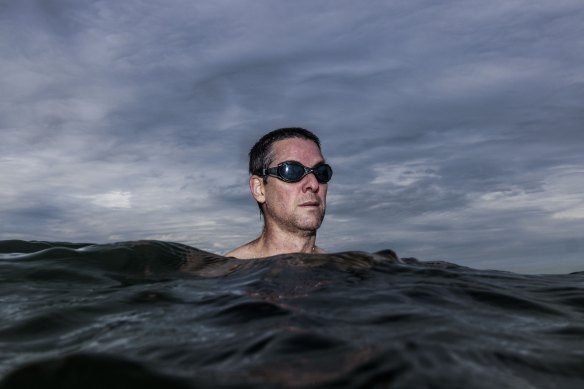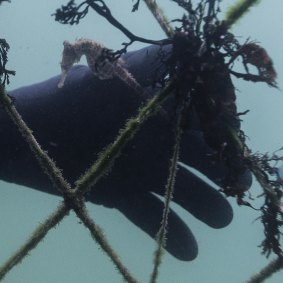The state government’s shark net program aims to determine three species of sharks – the tiger, white and bull shark – but the nets’ efficacy has been debated for years. Many critics say the technology is almost 100 years old and alternative and less harmful methods should be used.
For those who support the nets, they offer psychological comfort, says Dr Vanessa Pirotta, a marine predator researcher at Macquarie University.
But they offer little protection. Shark nets are not designed to create a complete barrier between swimmers and sharks, but rather they aim to detect sharks from frequenting the site.
Over the years, there have been significant advancements in technology, which include SMART drumlines and drone surveillance. Both are in place along the Central Coast.
Earlier this year, the government announced $85 million to fund the implementation of other shark mitigation tools, including increased shark tagging, improving community awareness and installing shark listening stations that provide real-time tracking of tagged sharks.

Brendan Rogers, who supports the removal of shark nets, has swum for years along the Central Coast.Credit:Brook Mitchell
Central Coast resident Brendan Rogers tries to swim most mornings but the possibility of bumping into a shark is never far from his mind. He says it’s a risk of entering the sharks’ habitat.
loading
“I think that maybe a long time ago, they were one of the better solutions, but I think there are so many other options now that are potentially safer to other wildlife as well,” he says. “There is no one silver bullet; the nets are old-fashioned. If we can use a combination of smart things – like technology [then that is better].”
Perhaps one of the most controversial aspects of shark nets is how many marine animals get caught in the nets. Of the 376 marine animals caught in shark nets during the 2021-22 reporting period, only 51 were the target species. The remaining 203 were threatened or protected species, including sharks, turtles and rays. Of these animals, 156 died, data from the NSW Department of Primary Industries (DPI) shows.
Among these were 16 leatherback turtles – the majority of which were caught on the southern Central Coast. There were also 28 white sharks, 19 green turtles and 52 smooth hammerheads caught, as well as 14 critically endangered gray nurse sharks.

A Sydney seahorse is caught in a shark net, one of hundreds of non-target species each year.Credit:Brook Mitchell
DPI oversees the shark meshing program and employs seven contractors, one in each region shark nets are installed: Hunter, north and south Central Coast, Illawarra and North, Central and South Sydney. The department hires contractors to inspect the nets every 72 hours and release animals.
What happens to injured animals is not entirely clear. If a contractor finds a live animal caught in the nets, they are to free it using instructions from the Shark Meshing Supervisor and contractors may then “disentangle, handle, treat and release any living marine mammal, marine bird or marine reptile in accordance with any relevant national or state guidelines where practical and safe to do so”.
A DPI spokesperson says the nets were actively managed to ensure minimal impact on marine animals and that since the shark nets were introduced in 1937, there had only been one fatality at meshed beaches.
“The NSW government will continue to work with coastal councils to ensure that community preferences are balanced against effective shark mitigation for bathers,” the spokesperson says.
“Contractors are required to check the shark nets within 72 hours of the previous inspection and release live animals with the least possible harm.
“If an injured marine animal is caught in the nets, DPI fisheries will liaise with Taronga Zoo directly and organize the potential drop-off of the injured animal for assessment and treatment.”
However, Taronga Zoo says their wildlife hospital accepts and treats many animals but their records indicate they have not received “any wildlife impacted by shark nets for many years”.
When pressed further, a government spokesperson provided no further clarification about the fate of injured marine wildlife.
Sea Shepherd threatened and endangered species campaigner Lauren Sandeman says the true number of animals impacted by the shark nets is much higher than reporting shows.
“Any released animals that are still alive are left to nature and there is a strong likelihood that they will succumb to their injuries. But those deaths are not recorded in the program,” she says.
“We’ve seen footage from the program of animal releases that sink to the bottom of the water but they count those as a live releases. [The program] doesn’t track animals after they are released.”
Pirotta says the combination of targeted and non-targeted species caught in nets highlighted the push to move towards less invasive shark mitigation methods.
loading
“Sharks are not actively out to target people,” she says. “The majority of people don’t want to see wildlife harmed, so we need to work towards smarter solutions that collect information so we can learn more about them.”
Get to the heart of what’s happening with climate change and the environment. Our fortnightly Environment newsletter brings you the news, the issues and the solutions. Sign up here.
